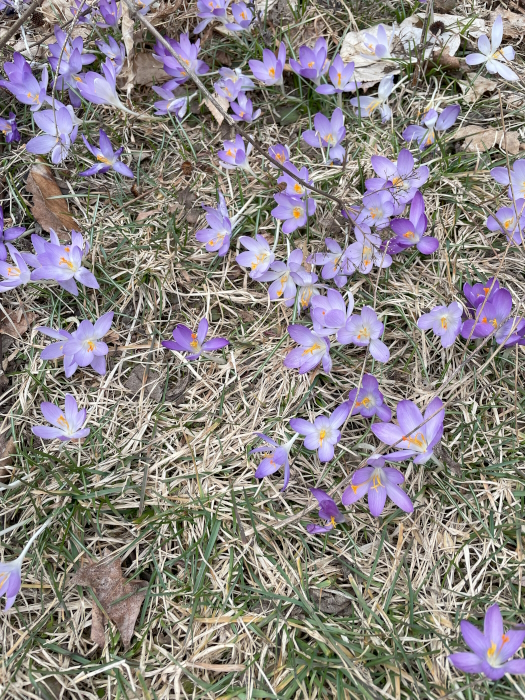During my daily walks in the woods with the hound, as she runs her nose along the ground tracking all the creatures that have passed through, I am running my eyes over the ground, searching for signs of emerging plants. It’s a mutually enriching experience for us both.
The snowdrops snuck up first, as always. Galanthus nivalis, while native to Europe and Asia, has naturalized here and will roam a little in the yard. It’s hardy enough to keep its blooms after being buried in snow and doesn’t mind fluctuating temperatures from last week’s warmth to this week’s freeze.
Daffodils, while being cheerful, are not my particular favorite so I cut them and make bouquets. I enjoy seeing their tips poking through, however. Bulbs are more visceral than other plants in their route from below ground to above. There is no trace of them and then there is. I forget where they were planted and when, and then suddenly one morning a shoot appears.

The crocus is an important early source for pollinators and, on warm days, I’ve seen bees enjoying my patch. While none are native here, they are not problematic in the landscape and are easy to source in the fall when they need to be planted. They naturalize quickly and because their blooms are finished by the time the grass needs mowing, planting them in lawns is a nice touch. Crocus sieberi, a Mediterranean native, and Crocus vernus, from the Netherlands, are the most commonly found.
The hepaticas — Americana and acutiloba, commonly known as liverleafs, are similar enough to need an identification key. I’m looking for their pale pink to white bracts in the bare woods. They should be easy to spot even though, at 6 inches tall, they are quite small.
I’m lucky to have quite a few bloodroot throughout my landscape. These native corms were used by Indigenous people to treat fevers. Look for it as Sanguinaria canadensis. The white flowers are showy but live up to the name of spring ephemerals and tend to disappear within a week. The foliage unfurls after blooming and is a single stem with a large round, cutout leaf that lasts through the season, becoming an attractive groundcover.

Because of deer, it’s rare to find trillium, another lovely spring flower. They are like tulips for deer, a delicious snack. If you have a fenced yard or container garden, try growing them. I’ve been warned to carefully choose a supplier, however. Many trilliums sold commercially are not cultivated, leading to population loss in their native habitat.
The trout lily, also known as a dogtooth violet (Erythronium americanum), has cool mottled foliage and a tiny vase-shaped flower that hangs upside down, making it difficult to photograph (I’ve tried). Go for a side shot. It likes to pop up from under the leaf cover in sunny locations. It gets the “trout” part of its name from the resemblance of its leaves to brook trout markings.
Virginia bluebells (Mertensia virginica) are sky blue in a tubular-shaped bloom that droops from the top of the plant. They are in the borage family. I have yet to find them growing outside of cultivation, but I’m eager to try them in my woods. I’ve found them commercially as bare-root plants and seeds. Seeds need to be cold-stratified so try for a winter sowing.

Besides deer, the early growth of invasive species that shade out and displace spring ephemerals in woodlands is the biggest threat to their survival. Most of the plants I’ve mentioned are becoming harder to find. In my woods, the barberry leafed out two weeks ago and dominates the spaces where these plants would otherwise be found. When I look into the forest, it seems like the mass of green growth in the understory would be a good sign, but it’s not. Another season of flame-weeding, a method of concentrated burning of stalks of barberry, is ahead for me.
For a significant display of flowering spring bulbs, visit Stonecrop Garden in Philipstown, which opens April 1. They plant tens of thousands of bulbs.

I loved this column on spring flowers. If you want some Virginia Bluebells, I have them taking over my flower beds. I started with one bare-root plant. Mine have begun to bloom, but there are many many baby plants that I love to give away. You didn’t mention that the buds are pink and the flowers blue — so unusual.